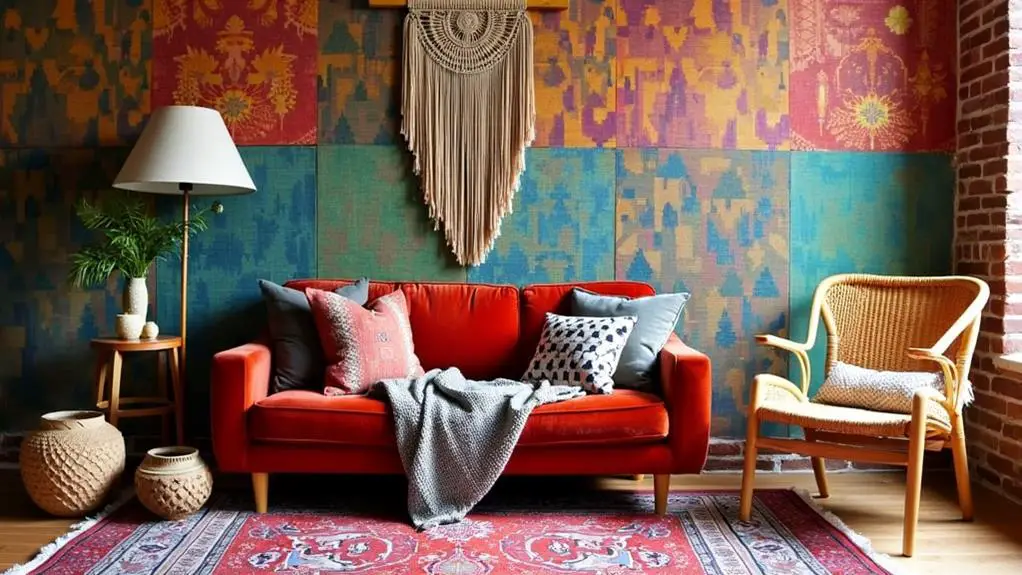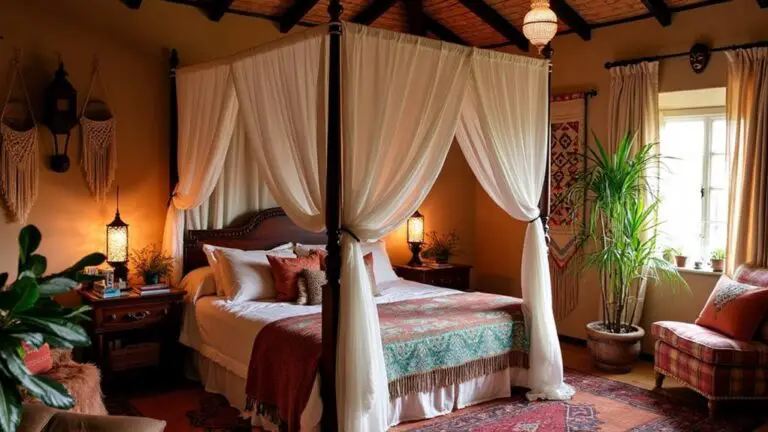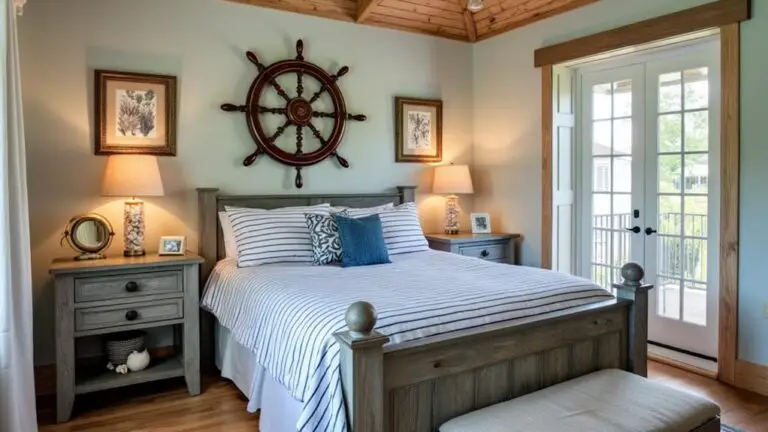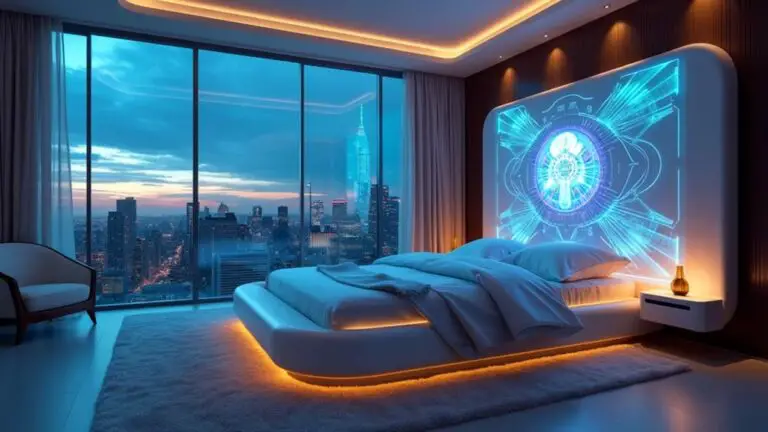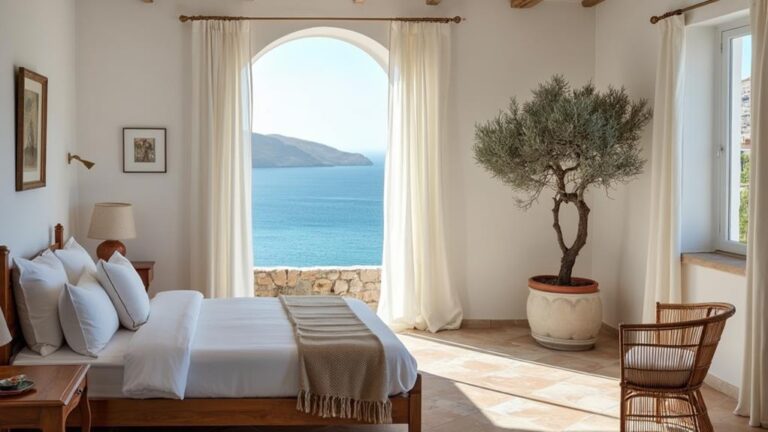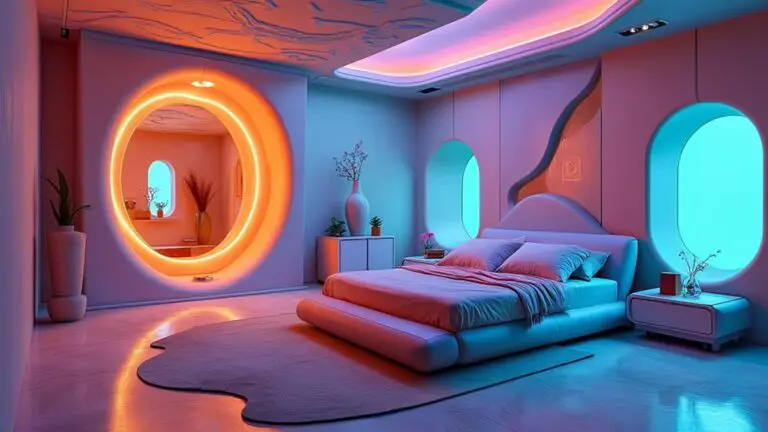Texture Takeover: Adding Depth to Dull Spaces
I've transformed countless dull spaces into vibrant, enchanting environments using the power of texture. By layering different materials, I create visual interest and depth that engages the senses. I love mixing smooth surfaces with rough ones, incorporating natural elements like wood and stone for authenticity. Textiles play an essential role too – think plush rugs, soft pillows, and organic fabrics. I often contrast textures, pairing sleek metals with cozy fabrics or rough stone with polished surfaces. Accessories like woven baskets, chunky throws, and textured wall art can elevate any room's design. There's so much more to explore in the world of texture takeovers.
What To Know
- Mix various textures like rough and smooth to create visual interest and depth in interior spaces.
- Incorporate natural materials such as wood, stone, and jute for authenticity and warmth.
- Layer contrasting textures, like velvet against linen, to add dimension and sophistication to rooms.
- Use textured accessories like woven baskets, chunky throws, and wall hangings to enhance overall design.
- Combine soft fabrics with hard surfaces to create dynamic and engaging environments.
Understanding the Power of Texture
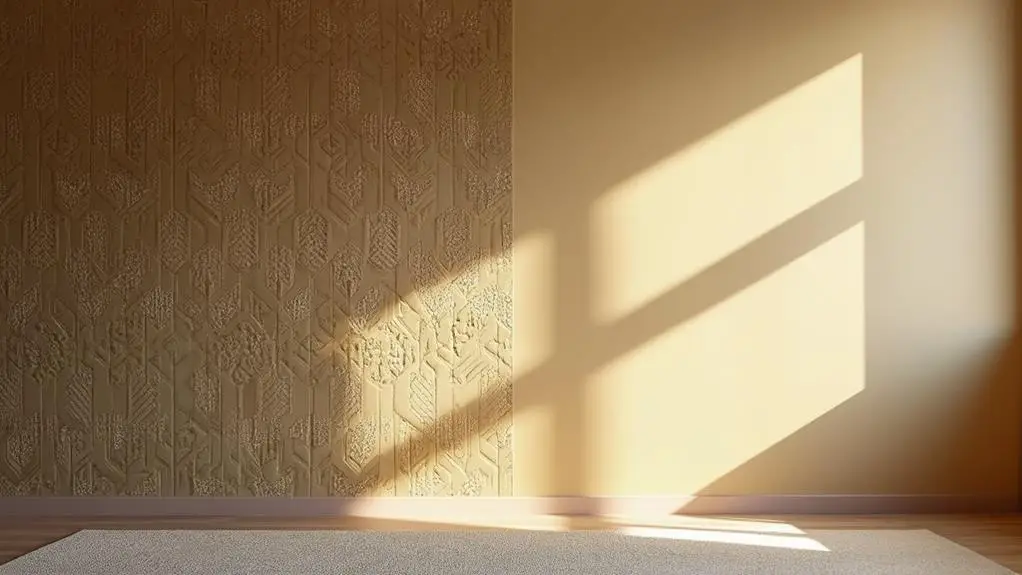
In the world of interior design, texture reigns supreme. I've discovered that it's the secret ingredient that transforms lackluster spaces into enchanting environments. By incorporating various textures, I can add depth and dimension to any room, creating a visual feast for the eyes.
It's not just about looks, though. I've learned that tactile textures play an essential role in making spaces feel more inviting and comfortable. Whether it's plush fabrics or natural materials, these elements work together to create a warm, cozy atmosphere.
I love experimenting with different textures, layering rough with smooth or combining shiny and matte surfaces. This approach allows me to craft multidimensional spaces that engage the senses and nourish the soul.
The power of texture lies in its ability to elevate design beyond the visual, creating truly immersive environments.
Layering Textures for Visual Interest
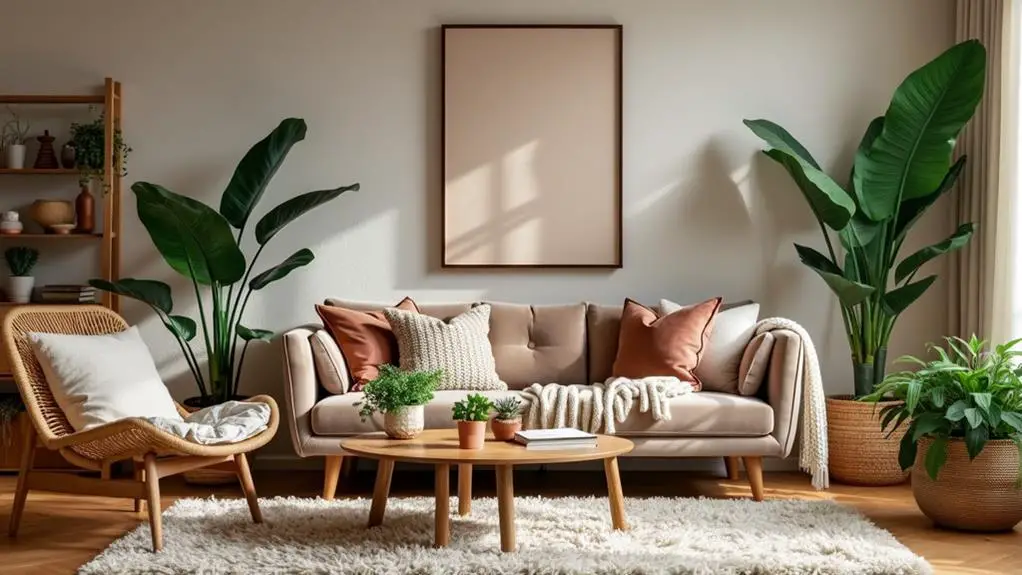
I've found that layering textures is key to creating visual interest in any space.
By mixing tactile and visual elements, I can balance contrasting textures to achieve a dynamic and engaging atmosphere.
I like to create depth through scale, combining smaller textured items with larger statement pieces to build a rich, multidimensional environment.
Mix Tactile and Visual
Frequently overlooked, the art of mixing tactile and visual textures can transform a space from mundane to extraordinary.
I've found that layering textures is key to creating visual interest and adding depth and character to any room. By incorporating tactile elements like woven baskets alongside visual textures such as exposed brick, I can craft an inviting atmosphere that engages the senses.
I love playing with contrasts, combining plush rugs with smooth leather or pairing boucle upholstery with velvet throw pillows. This interplay between rough and smooth not only adds complexity but also elevates comfort and visual stimulation.
To create a sophisticated environment that encourages relaxation and social interaction, I thoughtfully layer textiles and architectural details like crown molding.
Balance Contrasting Elements
Balancing contrasting elements is the key to mastering texture layering in interior design.
I've found that combining materials with varying finishes, like smooth and rough textures, creates visual interest and depth in a space. I love to pair contrasting colors and patterns with different textile textures to enhance the overall aesthetic.
It's amazing how a plush rug alongside sleek furniture can provide both coziness and sophistication.
I often incorporate natural materials like wood and stone with softer fabrics to strike a balance between industrial and organic elements.
This approach enriches the character of the room and reflects personal style. By strategically layering textures, I'm able to add warmth and create a curated look that's both engaging and inviting.
It's all about finding the right balance to transform a dull space into a dynamic, visually appealing environment.
Create Depth Through Scale
Creating depth through scale is a powerful technique in texture layering. I've found that combining textures of varying sizes can dramatically enhance the visual appeal of a space.
For instance, I love placing plush throw pillows on a sleek sofa to introduce contrast and interest. I also use large, textured rugs beneath smaller furniture pieces to ground the room while defining distinct areas.
To add dimension to walls, I mix oversized art with smaller decorative pieces, drawing the eye across the space. I create an intriguing interplay of scale by incorporating varying heights in plants and accessories, like tall floor vases alongside low-profile furniture.
Natural Materials in Interior Design

I'm a firm believer in the power of natural materials to transform interior spaces.
By incorporating raw elements like wood, stone, and jute, I've found that rooms gain an immediate sense of authenticity and warmth.
These sustainable choices not only support eco-friendly design practices but also introduce tactile sensations that synthetic materials simply can't match.
Authenticity Through Raw Elements
Natural materials breathe life into interior spaces, infusing them with authenticity and character.
I've found that incorporating organic materials like wood, stone, and jute not only enhances the aesthetic appeal but also adds warmth and depth to any room. These raw elements possess inherent variations in color and texture, creating visual interest that synthetic materials simply can't match.
I'm particularly drawn to rustic wooden furniture and stone accents, as they evoke a sense of connection to nature and foster a calming atmosphere.
The tactile quality of these materials encourages interaction, making spaces feel lived-in and comfortable.
Additionally, by using sustainable options like rattan and bamboo, I'm supporting eco-friendly design practices while enriching interiors with unique textures.
It's clear that embracing authentic, natural elements is key to creating spaces that are both visually striking and environmentally conscious.
Sustainability in Material Choices
Sustainability in material choices has become a cornerstone of thoughtful interior design. I've found that incorporating natural materials like wood, jute, rattan, and bamboo not only enhances the aesthetic appeal of a space but also promotes sustainable design practices. These organic materials bring warmth and character to interiors while reducing our reliance on synthetic products.
When selecting materials for my projects, I prioritize environmental responsibility. Here's why I opt for sustainable choices:
- Support local economies
- Reduce carbon footprint
- Minimize waste
- Promote long-term cost-effectiveness
I'm particularly fond of using reclaimed wood in furniture and decor. It adds unique character while minimizing waste.
The durability of natural materials often means less frequent replacements, benefiting both the environment and my clients' wallets. By embracing sustainable material choices, I'm creating inviting spaces that connect with nature and contribute to a greener future.
Tactile Sensations at Home
With the growing emphasis on sustainability, tactile sensations have taken center stage in home design. I've found that incorporating natural materials like wood, jute, and bamboo adds warmth and depth to my living spaces. The rough textures of these organic elements create a comforting environment that invites relaxation and encourages social interaction.
I love how combining different natural materials enhances the complexity of a room. By layering textures, such as pairing rough wood grains with smooth surfaces, I create visual contrast that makes my interiors more engaging.
Natural fibers in rugs and upholstery not only enrich the character of my spaces but also support eco-friendly design practices. The tactile sensations from these materials contribute to a warm ambiance that feels both sophisticated and inviting.
It's amazing how these organic elements can transform a dull space into a curated, chic atmosphere.
Contrasting Textures for Dimension

Interior design has evolved beyond mere color coordination, embracing the power of contrasting textures to create depth and dimension.
I've found that layering textures is key to achieving a rich aesthetic and visual interest in any space. By combining soft fabrics like boucle with hard materials such as metal or wood, I can instantly add depth to a room. The juxtaposition of natural textures against polished finishes creates a dynamic and engaging environment.
To effectively incorporate contrasting textures, I follow these guidelines:
- Pair plush rugs with sleek leather furniture
- Use deep velvet against light woven fabrics
- Combine rough stone with smooth surfaces
- Layer different textures to define areas in open spaces
This approach not only enhances comfort but also adds sophistication and organization to the overall design, transforming dull spaces into enchanting interiors.
Textiles: Soft Touches, Big Impact
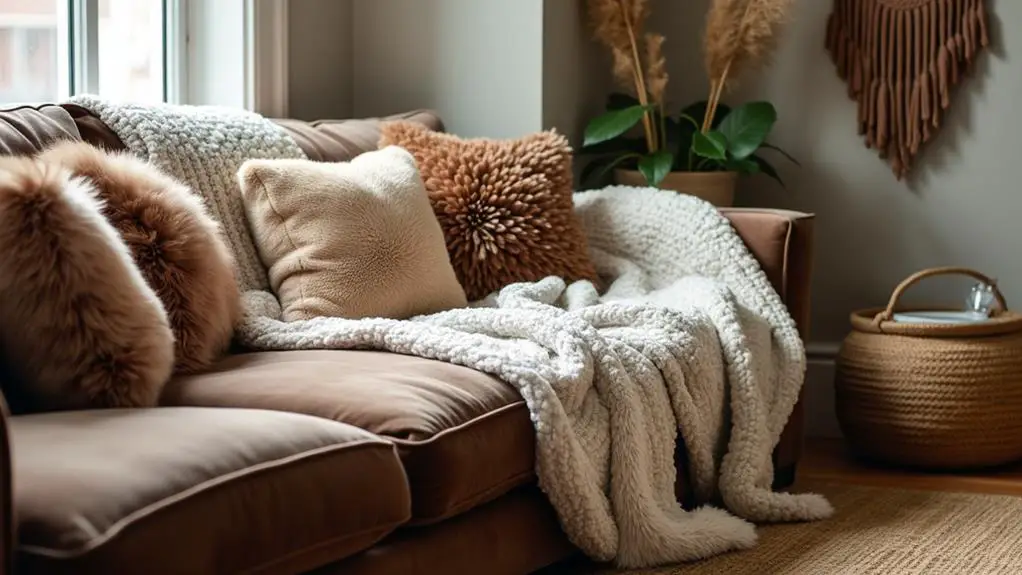
Textiles play an essential role in transforming spaces from stark to inviting. I've found that incorporating a variety of materials, from plush rugs to soft throw pillows, can instantly add layers of warmth and comfort to a room.
By mixing textures like boucle and velvet, I create visual interest and depth that engages the senses and encourages relaxation.
I love using contrasting textures to make spaces more dynamic. Combining smooth fabrics with rougher materials adds an inviting dimension that draws people in.
For sustainability and character, I often turn to organic textiles like jute and cotton. These natural materials not only enhance the aesthetic appeal but also promote a cozy atmosphere.
With strategic placement of textiles, I can transform even the dullest spaces into rich, tactile environments that beg to be touched and experienced.
Incorporating Texture Through Accessories
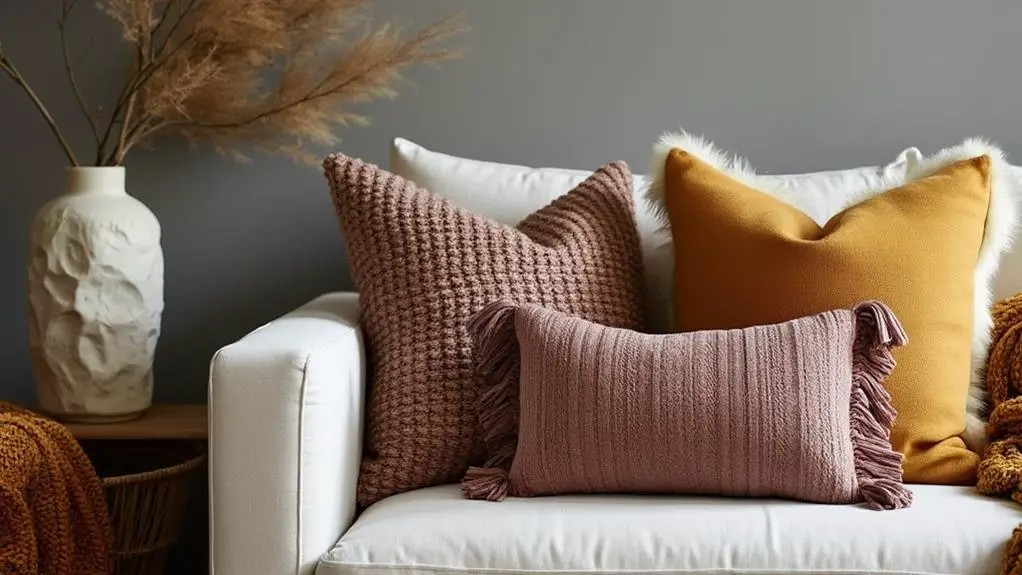
Accessories offer a fantastic opportunity to infuse texture into any space without overhauling the entire design.
I've found that incorporating woven baskets, chunky knit throws, and plush pillows can instantly warm up a dull room.
Layered textiles, like mixing linen and velvet, create a sophisticated contrast that enhances the overall aesthetic while maintaining comfort.
To add depth and visual interest, I recommend focusing on:
- Natural materials (jute rugs, rattan decor)
- Contrasting textures (sleek metal with soft fabrics)
- Textured wall hangings or art pieces
- Mix of smooth and rough surfaces
These elements not only engage the senses but also elevate the room's design.
Conclusion
As I've explored the world of textures, I've discovered their transformative power. But there's one final secret I've been holding back. It's a technique so potent, it can revolutionize even the dullest space. Are you ready? Here it is: trust your instincts. That's right—your unique vision is the key. So go ahead, experiment boldly. Mix unexpected textures. Break the rules. You'll be amazed at what you can create when you let your imagination run wild.

